Summer had arrived and I was pondering which country to visit next. You know how it is. Time travels so fast in one’s retirement that summer is upon you before you realise that winter is past. In summer I prefer to go north but I had left thoughts about travels until late. Quick decision required. How about the three countries of the Baltic states, I thought: Lithuania, Latvia and Estonia. Yes, lots of history and medieval buildings in walkable cities. The next decision: should I take potluck and go independently or find a tour? Let’s make it easy and book a tour. Luckily there are so many tour companies out there that one can find the perfect tour by scanning a few websites over scores of hours over many days. Eventually in sheer frustration at the remarkable number of choices, one picks the one that appears to fulfil most of one’s criteria, clicks on the ‘pay’ icon and is committed, for better or worse.
The Baltic countries lie on the eastern shore of the Baltic Sea opposite Sweden, south of Finland and west of Russia and Belarus. Each has its own fascinating and varied history and language, but they share some history, for example, they were all part of the Hanseatic League (a trading organisation of merchant guilds in Central and Northern Europe) in the Middle ages; they were all occupied by Nazi Germany between 1941 and 1944; and then for many years they were Soviet republics. The Soviets finally recognised their independence in 1991. They are now democratic states, members of the EU and NATO and have strong ties with the Nordic countries. Known as the ‘Baltic Tigers’, the three countries have prospered since independence. All three of the cities’ historical centres have been designated UNESCO World Heritage sites.
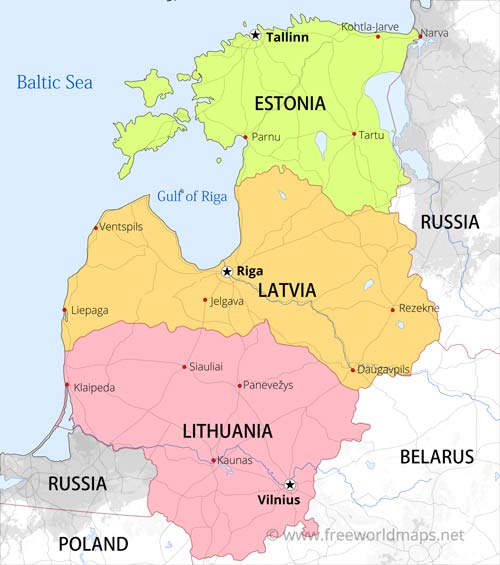
The tour that appealed to me was one that started in Vilnius, Lithuania, crossed Latvia and ended in Tallinn, Estonia, that is, a journey across the three countries from south to north taking in the three capitals and three Radisson hotels. Nothing wrong with the Radisson hotel group I suppose. Not exactly boutique, but you know what you are getting, and anyway, tour groups need large carparks and large breakfasts and the Radissons provide. The tour was advertised as a small group English speaking tour.
There were only a few of us at the group meeting on the first evening, two English, three Irish, one Pole and two Italians, who wished to be part of an English speaking group for unknown reasons, and a youngish Latvian guide from Riga. A nice small number. It was only the next day that it was realised that the group consisted of well over fifty travellers of several different nationalities and speaking different languages. The coach was full. “I booked a small group tour”, grumbled one of the English speaking contingent, who did not like large parties. It gradually came to light that many, mainly Americans, had cancelled their holidays owing to Russia’s invasion of Ukraine, fearing, no doubt, that the Baltic states might be next. A whatsapp image was circulating at the time:
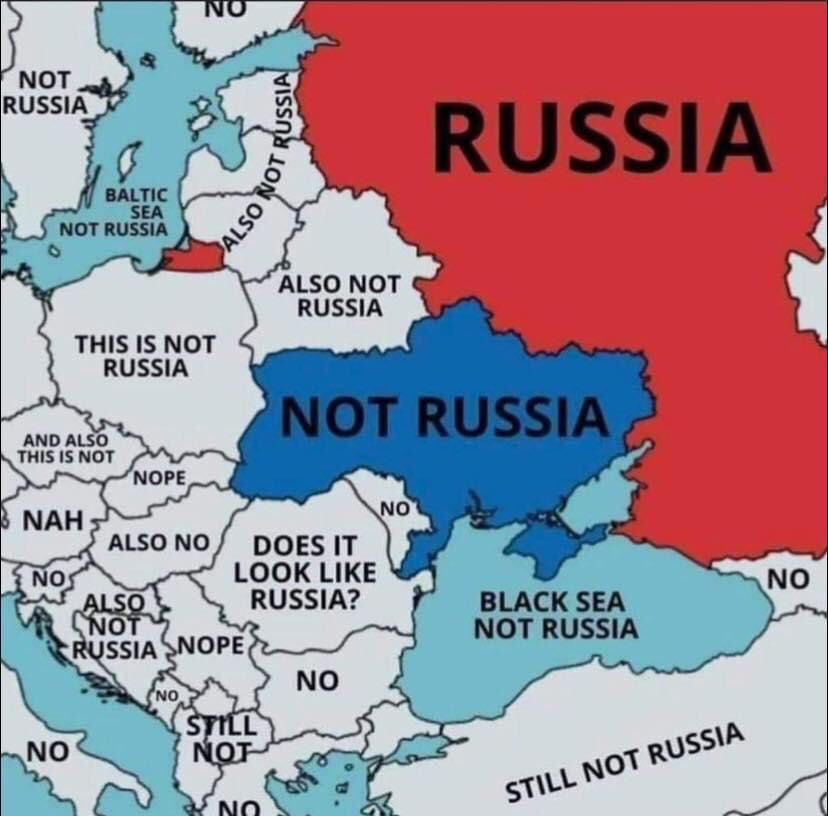
Anyway, due to this issue several tour groups had been hastily amalgamated into one. They included a large Spanish speaking group, a large Italian speaking group, a small German speaking group and us happy few English speakers. Our guide was multilingual and, although helped at different times during the tour by other guides, bore the brunt of the organisation and the commentary. Sitting at the front of the coach with his microphone, he moved seamlessly between one language and the other, giving the same information four times over. Phew.
Lithuania
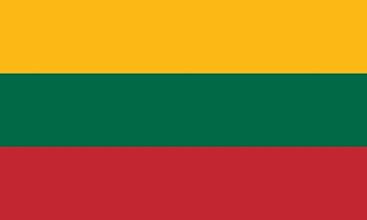
Vilnius
The Radisson Blu is on the edge of town, so I stroll a longish way into Vilnius on my first day to get the feel of the city. I have learnt from previous tours that it is a good idea to tag on a day or more at the beginning and end in order to rest and recuperate and get one’s bearings. Vilnius certainly lives up to the description given in the tour information of being a city of 1200 medieval buildings and 48 churches. Cobbled streets, towers and steeples greet the traveller in the old historic centre. Gazing down upon it all is the Gediminas tower, built by one of the Grand Dukes of Lithuania, Gediminas, out of wood. He is considered to be the founder of Vilnius. In the early 15th century, it was rebuilt in brick by a descendant, Grand Duke Vytautas.
Gediminas Tower
I always like to head for the highest point, so I plod slowly up the steep hill to the imposing red brick tower, the only part left of the original castle, with the Lithuanian flag flying above. There is some information inside about its history worth perusing. From there is a panoramic view over Vilnius, including the river Neris, flowing in a blue stripe through the city; the white Palace of the Grand Dukes of Lithuania; the Cathedral and its bell tower; and our Radisson Hotel in the distance. Of course I realise later that there is a handy lift up to the tower, one of those inclined lifts from which you can see the cityscape through the windows. This would have saved a lot of puff. I descend in it instead.
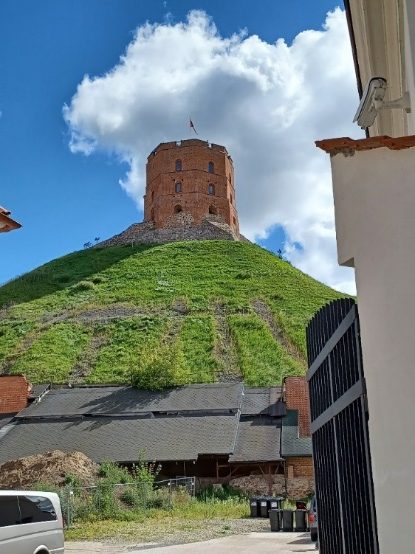
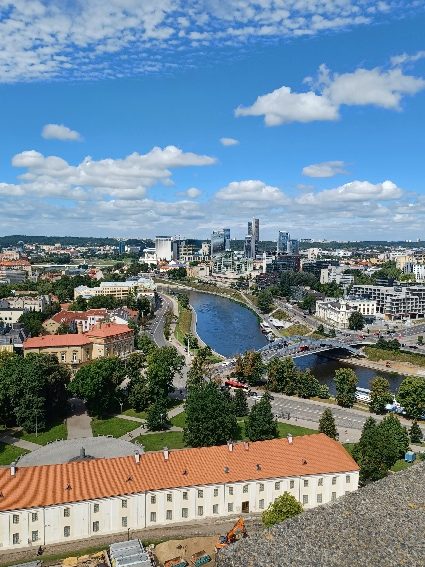
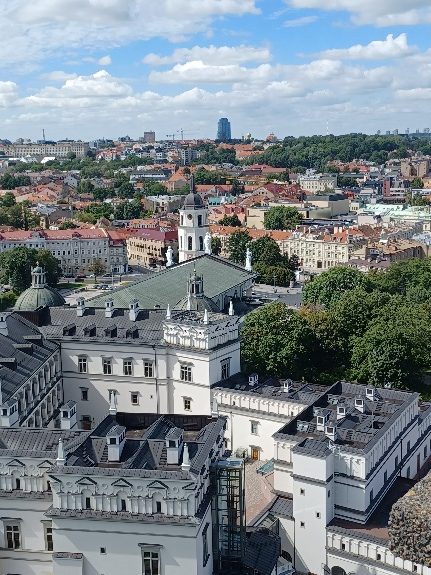
Vilna Ghetto
As I wander through the city, I come across the Jewish ghetto, known as the Vilna Ghetto, which had once been the Jewish quarter. There is a board on the wall of one of the streets showing photographs, information and a plan of the ghetto, which was established in 1941. Here and in the surrounding fields, the Nazis executed thousands of Jews. Others were deported to concentration camps. Lithuania, according to the information given here, suffered most from all Jewish communities in Europe from the Nazi persecutions. I did not know this before. Very sobering. Today, the area is full of shops and cafés. I go into one specialising in Lithuanian cuisine and order boletus (type of mushroom) soup and beetroot humous.
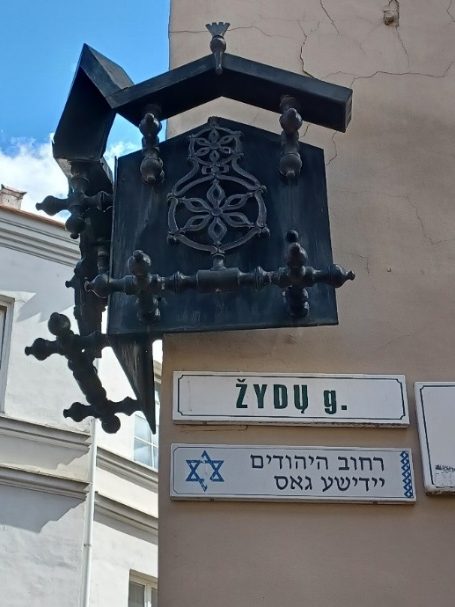
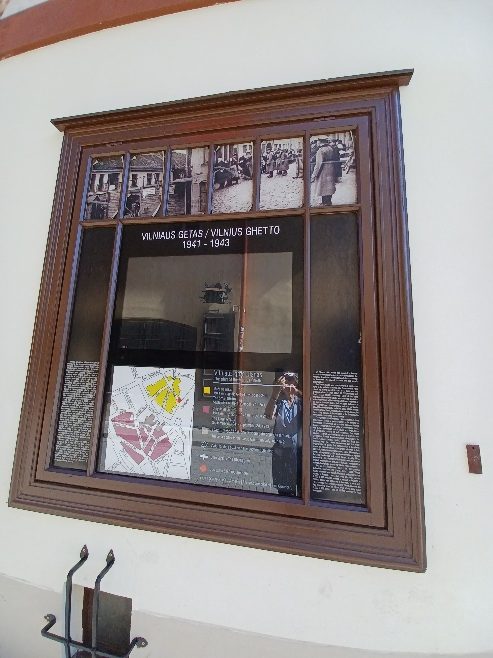
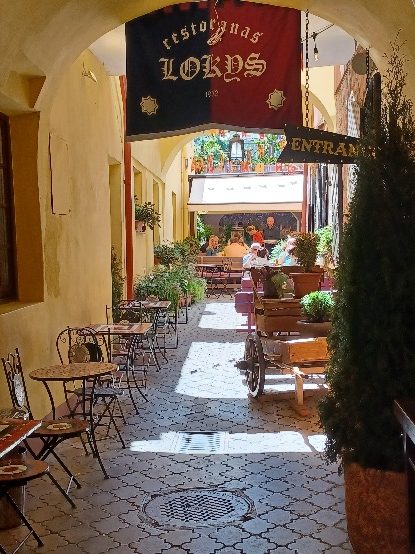
Republic of Užupis
Continuing my exploration, I come across the Vilnia river, where a sign tells me I have reached the Republic of Užupis and I cross a narrow bridge into its domain. Interesting, I muse. A republic within a republic? Across this river ‘border’, I walk between walls covered with street art and view other curious artistic works. Left desolate after the once thriving Jewish population had ‘departed’, Užupis was repopulated by artists, who declared it a republic on April Fools’ Day, 1997. One kilometre square with about 7000 inhabitants, the Republic has been accepted by the Government of Lithuania but no other country apparently. One can get one’s passport stamped here if one wants. I saunter into its main square where, atop a bronze sphere atop a column, the bronze guardian angel of Užupis is playing a trumpet. There are tables and chairs below her with café goers under sunshades.
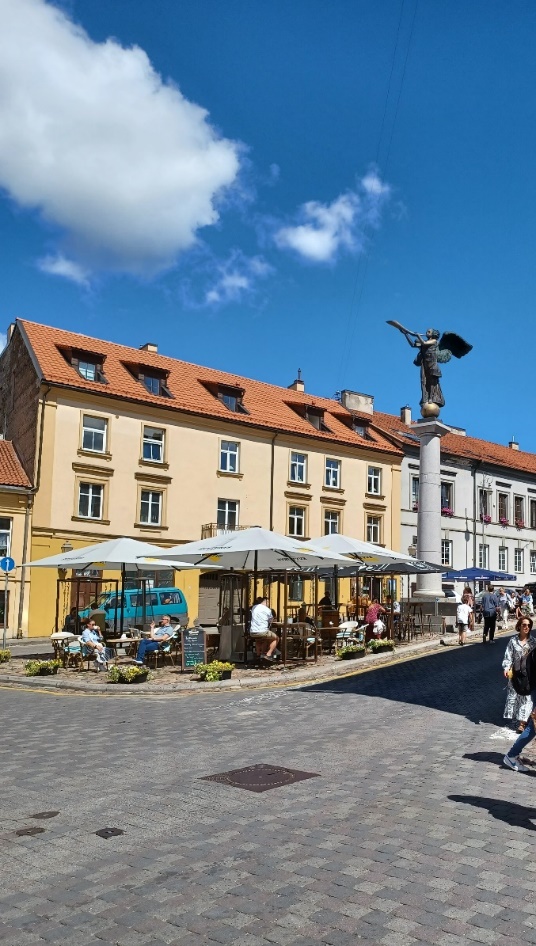
Amber
On the way back to the hotel, I notice an amber shop cum museum and enter its precincts. Amber, I read, is essentially fossilised resin from conifer trees which ends up buried under layers of sediments and washed into rivers and the sea. Because of the stickiness of resin, amber often incorporates insects or bits of plants, called inclusions, which are millions of years old. Around the shores of the Baltic states, much amber is washed up, no doubt due to the presence of so many conifers. I see some incredible art works, some quite large, in the forms of ships and animals, some small and intricate like jewellery, made out of this sultry yellow stone. Expensive though. It is known as Baltic Gold. According to some, it has healing powers and can fend off evil spirits. It has been traded since prehistoric times in the form of beads, for example, and has been found in Egyptian tombs and many other places. Footsore, I head back to the Hotel. I have had a stimulating reconnaissance of Vilnius. Nice and warm too. The sun shone all day.
St Peter and St Paul Church
The formal tour starts with a coach drive round the outskirts of the city with a stop at St Peter and St Paul Church, the interior of which is full of elaborate sculptures by Italian artists. The Italian group are pleased by this. “You want artists, send for the Italians!” Giovanni Pietro Peretti and Giovanni Maria Galli were specially brought to Vilnius by the founder of the church, Michal Pac, in the mid-1600s and between them they produced over two thousand stucco reliefs including cherubs and horses and figures of saints. “This interior is unique in Europe” says our guide. We all gawk enthusiastically. He points out the chandelier in the middle of the nave, in the shape of a boat, which has a square sail and a dragon on the prow. It is supposed to represent Noah’s Ark. Everyone photographs it. Unfortunately the façade of the church has scaffolding over it right now, largely obscuring it. The interior more than makes up for that though.
Our guide gives us a potted history. Lithuania was the last country in Europe to become Roman Catholic in 1387, he tells us. For over two hundred years (1569 – 1795) it was in a partnership with Poland called the Polish Lithuanian Commonwealth – The Kingdom of Poland and the Grand Duchy of Lithuania ‒ and their territory extended to the Black Sea, incorporating present day Belarus, south Estonia, Latvia, Poland, parts of Russia and Ukraine. A huge area. “It is due to the connection with Poland that churches in Lithuania remained Catholic”, we are told, “while those in Latvia and Estonia are predominantly Lutheran”.
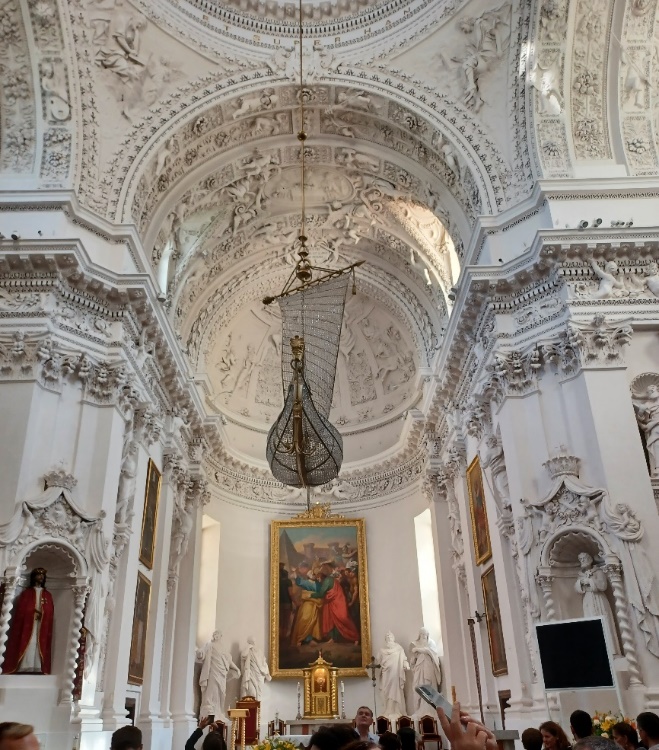
Vilnius Cathedral
Before Roman Catholicism, Lithuania was a pagan country. In fact the once sacred pagan site, where the two rivers of Neris and Vilnia meet, became the site of the stunning white Basilica of St Stanislaus and St Ladislaus, also known as Vilnius Cathedral. The coach drops us all off at this point, the first stop on the walking tour. We stroll round the inside of the Cathedral, which has been used for coronations of the Grand Dukes of Lithuania and, at a significant low point in its history, as a warehouse under the Soviets. “This is the most important Catholic site in the country, and houses the remains of Lithuania’s patron saint, Casimir”, says our guide pointing to the decorated chapel in which he came to rest. Many bishops, Grand Dukes and Polish rulers are buried in the Cathedral’s crypts. Alongside the building stands a 57 metre high white bell tower, containing 15th century bells. The city’s oldest clock is at the top. “You can climb the tower if you want in your free time later on” our guide suggests. “Only 135 steps”.
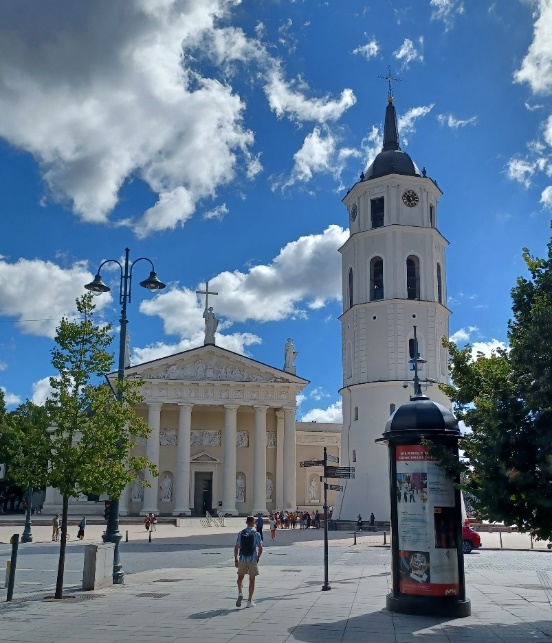
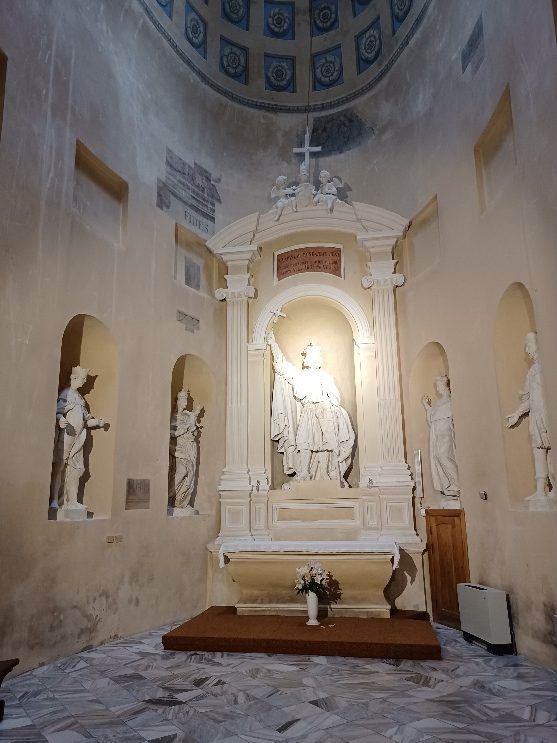
The highlights continue including a few of the other 48 churches: a Russian Orthodox church, which has a bright green East end where the bodies of three fourteenth century martyrs, Anthony, John and Eustathius, are located with their feet poking out under a green cover. Quite why their feet are exposed is a bit of a mystery. Another, the Bernadine Church and Monastery, is a large old red brick Gothic building, which was also used as a warehouse under the Soviets. Outside it is a statue of Adam Mickiewicz, a Polish bard. Chopin set some of his poems to music we are told. I went to Poznan in Poland once and there is a university named after him there.
We pass the much photographed Old Lamplighter statue with its shadow on a wall. The Lamplighter perches on a tall granite pedestal lighting the gas lamps, which was a worthy profession in the days when streets were lit by gas.
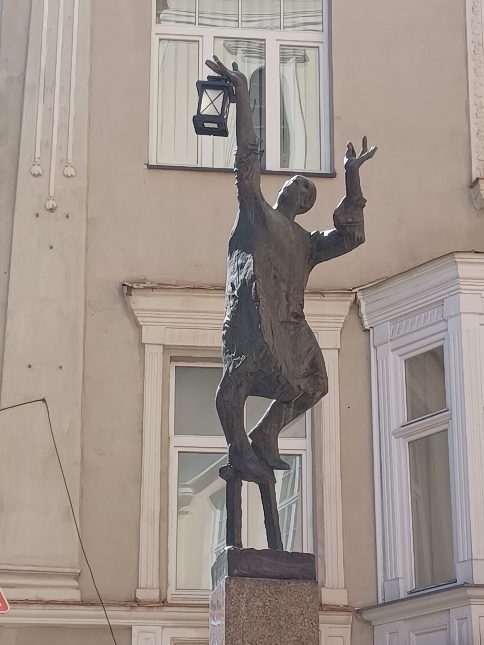
The next building we view has two huge flags draped over the portico, that of Lithuania and Ukraine. It is the Presidential Palace and the two flags are the same size, which signifies the extent of Lithuania’s support for Ukraine since the Russian invasion. The palace has been the residence of many worthies during its long history: bishops, dukes, emperors, and tsars, and now serves as the official office of the President. The final stop is in the main Town Hall Square. A plaque on the outside wall of the City Hall reads “Anyone who would choose Lithuania as an enemy has also made an enemy of the United States of America. George W. Bush President of the U.S. Vilnius City Hall. November 23rd, 2002”.
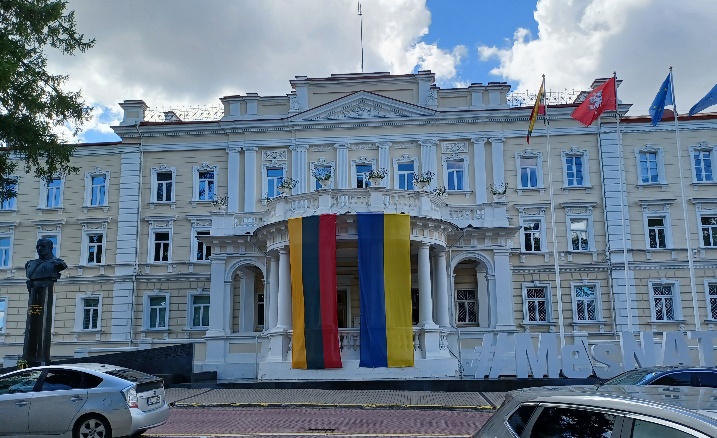
Trakai Castle
After lunch is an optional excursion to Trakai Castle just outside the city. I opt to visit. Trakai Castle was Lithuania’s medieval capital and is situated on an island in a lake. It is very orange, and looks like something out of Disneyworld with the sun shining on its orange brick walls and tiled rooves with orange towers in the corners. It is surrounded by dark green trees and reached via a wide wooden bridge. A few yachts lie peacefully in front alongside a small pontoon. Once through the main gatehouse I am in a large courtyard with the impressive ducal palace ahead and clamber up some wooden stairs to explore. Inside one of the towers is a stained glass window featuring the Grand Duke Vytautas, he who constructed the brick tower atop Gediminas Hill. He also completed Trakai Castle, built as a residence for the Grand Dukes, in the fourteenth century. There are many fine rooms in the castle with frescos and various artefacts. Marvellous place. It looks in good condition, but, of course, it has been reconstructed many times.
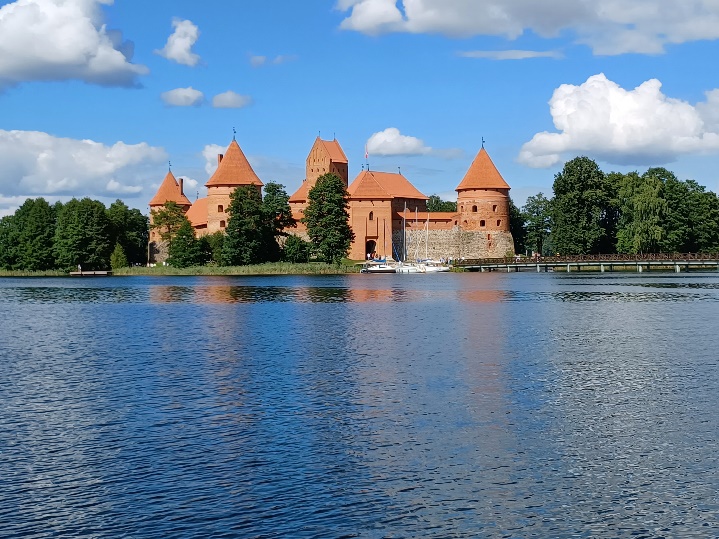
Baltic Way
Amongst a group of over fifty, there is always going to be someone who is late. Of course one can always give the reason that one got the time zone wrong or some other nefarious excuse. The guide dutifully counts the occupants of the coach. “One person is missing. Does anybody know who it is?” He counts us all again just to make sure. No, still one missing. He gets his list out and proceeds through the coach ticking us off one by one. OK, missing person identified. He hops off to go and locate him, who eventually turns up, unabashed. Never mind. It happens to us all. However, when said person is late on the second day too, those half asleep, who have heaved themselves out of bed, packed their bags, and stuffed down their breakfast with no time to clean their teeth afterwards in their efforts to board on time, may be somewhat less forgiving. The guilty person eventually plods slowly up the coach steps, runs the gauntlet of baleful glances, and disappears to the rear.
We are driving up the Baltic Way, a route stretching between the three capitals from Vilnius, through Riga, to Tallinn, which was lined by over two million people holding hands in 1989 to demonstrate for independence. Our guide tells us he was seven years old at the time when he was bussed off with his parents to be part of the chain near Riga. Lithuania was the first of the Baltic states to declare its independence from the Soviet Union in 1990. The other two soon followed.
Hill of Crosses
We are on our way north via the famous Hill of Crosses into Latvia. I am sitting in the front seat of the coach with my fellow traveller from Poland, who grabbed this sought-after seat after breakfast. Good stuff! One gets such a good view of the countryside through the coach’s large windscreen and she, Polish friend, has become pretty nifty at acquiring good seats. The scenery is flat and green with grass and trees as we approach the Hill of Crosses. The Hill is not much of a hill, more of a small mound, atop which are thousands of crosses, from tiny to huge. Some have statues of the Virgin Mary with them, some are carved and some have rosaries draped over them. The Hill is a major site of Catholic pilgrimage. “The Soviets forbade people to put crosses here”, says our guide, “but this just increased resentment. So, many Lithuanians placed crosses here despite the ban”. The area became a symbol of the struggle for independence. The Soviets even burnt some of them, the crosses I mean, which were made of wood, but they were replaced. We wander over the mound looking at some of the inscriptions. It is quite moving.
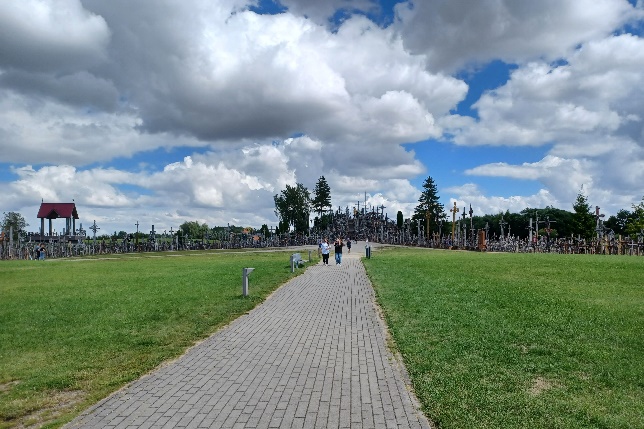
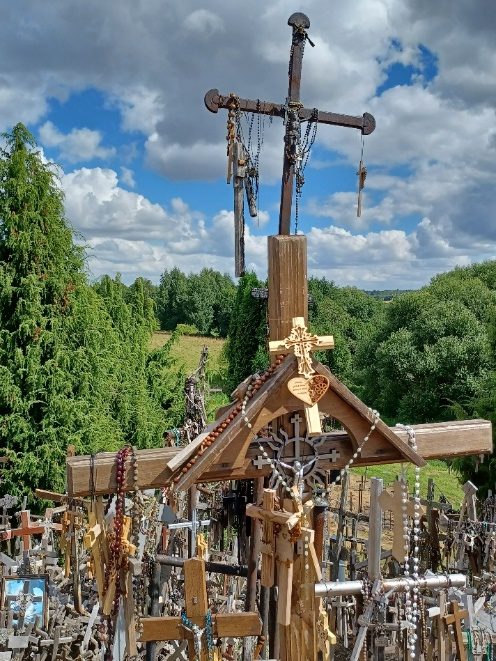

Leave a Reply